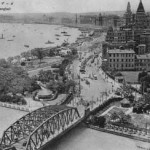76 Years Ago, in Shanghai
- By Peter Harmsen
- 20 April, 2013
- 21 Comments
 In April 1937, Shanghai was only four months from descending into war. In August of that year, full-scale hostilities would break out between Chinese and Japanese forces in the city. But in the spring, exactly 76 years ago, the local and foreign residents were blissfully unaware of what lay in store.
In April 1937, Shanghai was only four months from descending into war. In August of that year, full-scale hostilities would break out between Chinese and Japanese forces in the city. But in the spring, exactly 76 years ago, the local and foreign residents were blissfully unaware of what lay in store.
A look in the North-China Daily News from that time confirms the impression of a community going about its normal business, even though the shadow of war was looming ahead. Among the foreign naval vessels moored along Shanghai’s waterfront was Japanese cruiser Myoko, which did not, however, commit any acts of war, but instead received 658 children from Shanghai’s primary schools, giving them tours of the facilities onboard.
One of the big political discussions of the day concerned the question of whether to disband the Shanghai Volunteer Corps, charged with guarding the International Settlement. The paramilitary unit, a multinational outfit with large British and Russian segments, was a costly item for the municipal authorities, but it had proved extremely useful in times of danger in the past, including various waves of rebellions. The corps was “an integral part of the machinery of the settlement’s security,” the paper reported, saying reassuringly that all talk of disbanding it unjustified.
Crime also featured high on the news agenda. The North-China Daily News reported about harsh new measures against the opium trade, such as the death penalty against addicts who had been cured of their addiction twice but were caught using the drug a third time. “The truth is that addicts have been given many opportunities to correct their ways,” said Kan Nai-kwang, the director of the National Opium-Suppression Commission. “From experience it has been learned that only the most severe penalties in such cases can possibly exterminate an evil.”
Counterfeiting was another form of crime endemic to Shanghai. In the city’s southern part, almost exclusively inhabited by Chinese, the People’s Educational Institute saw record visitor numbers for an exhibition displaying hundreds of forged banknotes alongside the real thing. There was apparently a real need to be able to see the difference. “No exhibition held at the institute recently has been as successful as the present one,” an unnamed official told the paper.
Underpaid Chinese labor, and how it financed cheap consumption in the west, was also a topic of debate in April of 1937. Especially the tough work environment in the textile mills came under criticism. “Foreign mill-owners, particularly the Japanese, depress working conditions throughout the country,” said Chu Shu-fan, a Chinese labor official, blasting the 11-hour work days that were the norm in the factories. Conditions in Chinese-owned mills are even worse, the foreign plant owners retorted.
Meanwhile, high society continued its life of luxury, amid intense public interest. The North-China Daily News reported elaborate weddings at the Holy Trinity Cathedral, and the passage through Shanghai of various VIPs. Among the latter was An-chin Hutukhtu, one of 160 “living Buddhas” in Tibetan Buddhism, who had arrived in Shanghai from Lhasa via India.
Overall, the impression a casual visitor to Shanghai would have had in the spring of 1937 was of a prosperous city largely at peace. But dangers were looming on the horizon. In the north of the country, the Japanese Army was making itself an ever more palpable presence. “Much remains to be done before sweeping generalizations regarding the strength of China can be accepted,” the paper’s editorial writers cautioned. “The tendency to overcall hands is not a Chinese monopoly, but it may be much more dangerous in this country than in many others.”

 Copyright © 2024
Copyright © 2024
Leave a Reply